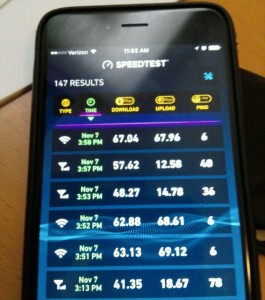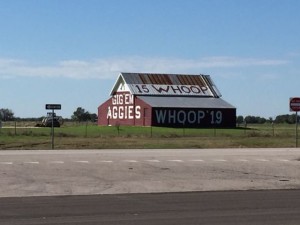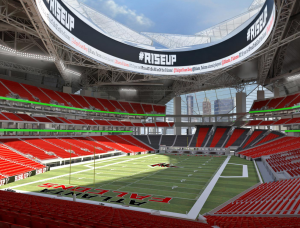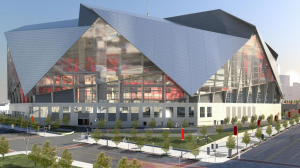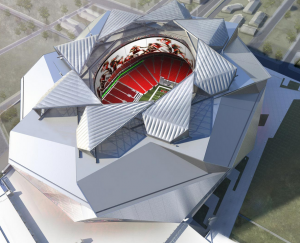
Texas A&M student at recent Aggies football game. Photo: Paul Kapustka, MSR (click on any photo for a larger image)
After initially designing the network with a traditional copper wiring system, a late spring 2014 decision by Texas A&M chancellor John Sharp reversed field, switching instead to an all-optical network for DAS, Wi-Fi and IPTV combined. The new network, now in full operational mode, is already being hailed as the future-proof path of the future of stadium network technology, with other schools and pro teams beating a path to College Station to see what they might learn.
With screaming speeds on both the Wi-Fi and DAS networks and plenty of capacity for now and the future, Sharp’s line-of-scrimmage call to go with an IBM and Corning optical-based network seems to be a huge score, according to a school official who brought the idea to Sharp’s attention.
Editor’s note: This story is part of our most recent STADIUM TECH REPORT, the COLLEGE FOOTBALL ISSUE for 2015. The 40+ page report, which includes profiles of stadium deployments at Texas A&M, Kansas State, Ole Miss and Oklahoma, is available for FREE DOWNLOAD from our site. Get your copy today!
Last-minute switch from copper to optical
“We had got pretty far down the road with an older, but tried and true [network] architecture,” said Phillip Ray, Vice Chancellor for Business Affairs at The Texas A&M University System. But after hearing and reading about the possible potential of an optical fiber-based network system, Ray brought in Corning and IBM representatives over school spring break in 2014 to discuss the possibility of switching to an optical fiber-based network for Kyle Field – even though the network would have to be ready for the 2014 football season.
“We had some face to face meetings with chancellor Sharp and discussed all the pros and cons,” said Ray, who had been charged by Sharp with overseeing the network deployment part of the $485 million Kyle Field renovation. Though Ray said he was under a “lot of pressure” to stick with the older-type design, he quickly got a green light from Sharp to take the optical choice and run with it.
“If we had gone copper, we knew that we would have had a network in the stadium for game 1,” said Ray. “But the pros of optical far outweighed the cons. Chancellor Sharp instead took a big risk, and took a leap of faith for all the right reasons. He said, ‘this is the chance of a lifetime, to really move the ball and shoot for the top!’ “
According to Ray, the total cost of the combined Wi-Fi, DAS and IPTV network ended up being “just north of $20 million,” but that cost was softened when the two largest cellular carriers, AT&T and Verizon Wireless, ponied up $10 million, almost half the cost.
“The carriers embraced it, funded it, and want to be with us down the road,” said Ray. “It was a paradigm shift for them, but they wanted to be involved.” While AT&T and Verizon are live on the DAS now, Ray said that Texas A&M already has a commitment from T-Mobile to join the DAS soon, and hopes to also add Sprint before long.
Aside from the leap of faith to go optical was the on-the-ground necessity to build the network quickly, since Sharp didn’t want to start the 2014 season without it. Ray said that Todd Chrisner – a former IBM employee who moved to Corning during the past year – “helped lead a Herculean effort” of gear suppliers, service providers and construction workers who finished Phase 1 of the network in time for the first game of last season. Phase 2 of the network also required quick moving, since it didn’t get started until Texas A&M blew up and then rebuilt the entire west side of the stadium between December 2014 and the 2015 season.
Again, the network (and the building) were finished on time.“We had a lot of Aggies involved [in the construction],” Ray said. “They knew they were going to be sitting in those seats for the next 35 years, so they worked hard.”
Now that it’s finished and working incredibly well, Ray said the Kyle Field network has already been visited by representatives from other colleges, as well as professional football and hockey stadium-networking types.
“We get calls every week, and we have people down to share what we learned – we’re an open book,” said Ray. And they’re able to tell a success story mainly because Ray, Sharp and others trusted themselves to switch from an OK play to one that could score a touchdown.
“If we had gone with copper we’d be so regretting it now,” Ray said. Having an optical-based network, he said, “sets us up for many years, and eventually will save us money. It was a lot of hard work and risk, and if it had fallen on its head, chancellor Sharp would have taken the heat. Instead, it’s one of the best decisions, ever.”
